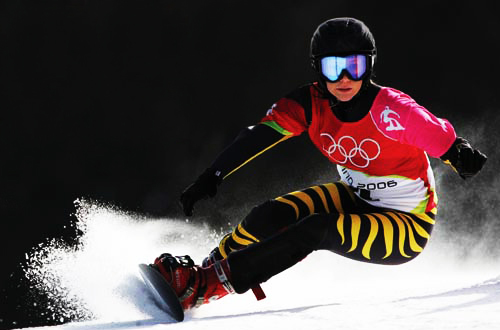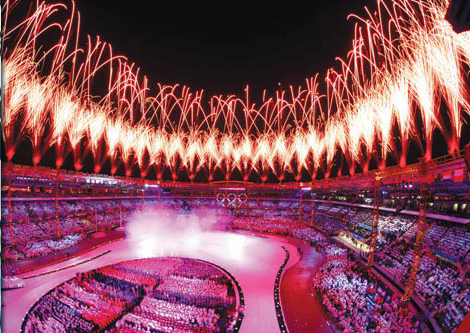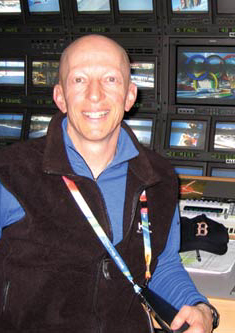BY LIBBY SLATE
 DOWNHILL RACER: "Some sports by their nature are more exciting," says
DOWNHILL RACER: "Some sports by their nature are more exciting," says
director Jeff Simon. Women's snowboard giant slalom is one of them.
(Credit: Shaun Botterill/Getty Images Sport)
When word reached NBC's Olympic broadcast truck that officials were reviewing footage of American star Bode Miller's slalom run to see if the leader of the event had straddled a gate and would be disqualified, director Andy Rosenberg sprang into action. While still covering the ongoing Torino competition, he issued an all-points-bulletin to his team to try to locate Miller, who had left the slopes 30 minutes earlier. Rosenberg then reviewed the footage he had directed to see if there were any incriminating frames. (There were.)
"There was a lot of scrambling," Rosenberg recalls. "We were all over the place. We knew where Bode's RV was. We'd had our airplane in the area covering the race, so we sent that. I'd look at the [plane's camera] angles and say, 'Zoom.' 'Pan to here.' I could see cameras, and thought, 'That must be Bode.' We sent a crew over–the cameraman probably walked backwards a quarter-mile in his ski boots while [our reporter] was talking to him."
Such victories and triumphs, keeping up with the surprises while chronicling the athletic events, are all in a day's work–an 18-hour-day, that is–for Rosenberg and his Olympic directing colleagues. Long track speed skating director Doug Grabert, for instance, had to keep an eye on the simmering feud between Chad Hedricks and Shani Davis, while snowboard director Jeff Simon followed Lindsey Jacobellis' ill-fated, last-second snowboard grab that caused a fall and cost her the gold.
As television directors of the globe's most celebrated athletic event, Rosenberg, Grabert and Simon are Olympians of a different sort. Their sporting equipment consists of cameras and consoles, not blades and bobsleds, and they view the Games on television monitors, much like most of the world.
It was 2006 figure skating director David Michaels at the helm when Sarah Hughes' fiery do-no-wrong program snatched victory away from Michelle Kwan in 2002 at Salt Lake City. Other indelible and oft-replayed images of Olympics past–Dan Jansen's heartbreaking fall in the 500-meter speed skating race at Calgary in 1988 the day his sister died, or goaltender Jim Craig scanning the stands for his father after the Americans' 1980 gold medal hockey win in Lake Placid–were also captured by the discerning eye of directors, calling the shots that became a part of history.
"There are two major factors in television directing," says Rosenberg, who helmed the alpine events at Salt Lake City as well as Torino, requesting the assignment because of his own love of skiing. "You're documenting the action of the event: who did what, what occurred. And there's the storytelling of it. These are actually people that are there. They have compelling stories or techniques. Sometimes it's a personal story. Sometimes it's an event story. The essence of the story makes it compelling drama."
Before Rosenberg ever strapped on his skis to scout the alpine skiing venues for camera locations, another director, Bucky Gunts, had already visited every venue of every sport for the same purpose. Gunts was coordinating director for NBC's Emmy Award-winning coverage of the Salt Lake City Games and repeated his duties as head of production for Torino.
A veteran of seven Olympics who has only seen one event live thanks to the time he spends in trucks and control rooms, Gunts worked full-time for the 18 months leading up to the Games, making numerous preliminary trips to Italy to survey camera placements. "For some sports, such as ski jumping, we'll isolate two or three of our own cameras at the top and bottom, and leave the coverage to the world feed. But for figure skating, we do our own thing. It's such a big part of the primetime show, we need to have our own cameras and rely on the host to enhance that."
Both Gunts and Robert Matina, his predecessor for CBS' Albertville, Lillehammer and Nagano broadcasts, have brought innovations to their respective networks' coverage. Gunts was instrumental in instituting the virtual technology first used at Salt Lake City, such as a line superimposed on the television screen to instantly show how many meters down-slope a ski jumper has landed and how that compares to other competitors; he also instituted the simulcast of two alpine skiers as they make their way down the hill. Matina won an Emmy in 1992 for helping to develop a "coming-and-going" camera that captures a contender's approach to a ski gate, detects when the visual level changes and switches position to record the descent.
 THE BIG PICTURE: Coordinating director Bucky Gunts used 55 cameras to
THE BIG PICTURE: Coordinating director Bucky Gunts used 55 cameras to
capture the opening night ceremony. (Credit: Clive Rose/Getty Images Sport)
The coordinating director determines what coverage is aired, but the event directors made their own decisions when it came to capturing that footage.
Rosenberg worked closely with Torino's world feed directors, integrating some of their camera angles with his own 15 cameras, for a total of 45 to 50 cameras, depending on the event. As was the case with many other venues, the skiing action was shot live-to-tape, with most of the virtual graphics added in post-production. The slalom, a technical event in which the skier constantly moves from one edge of the skis to the other from turn to turn, called for split-second timing from one shot to the next. For the downhill, where victory is measured by hundredths of a second, the challenge was conveying a sense of speed.
"This is as fast as you get," Rosenberg says. "The skiers are going 80 to 90 miles an hour, and are absolutely on the edge of destruction. They're going through extreme compression and G-forces in two minutes." With safety restrictions on how close the cameras could be, and longer lenses slowing down the onscreen action, Rosenberg used a high-speed specialty camera called the Super-Loupe, which runs 500 to 2000 frames per second.
"We were able to get some extreme close-ups of the skiers and their skis, recording the tension when they're in a turn, the compression when their muscles are screaming, the skis flexing like they're going to break under the high speed and pressure put on them," Rosenberg reports. He also used a super-slo-mo camera at 90 frames per second for replays, and experimented with point-of-view shots during a training run, taken from cameras mounted on a skier's helmet, boots and chest.
Torino 2006 was a far cry from Jean-Claude Killy's gold medal downhill run in Grenoble 1968. Joe Aceti, this year's DGA Lifetime Achievement Award winner for Sports Direction, who was in ABC's broadcast studio during that Olympics, remembers, "there were maybe 18 cameras, and they all had the same lens; they were numbered camera one, camera two and so on. Each one weighed 300 pounds. You couldn't just carry it up–you had to have a snowcat drive it, and two or three guys set it up.
"There were no fancy gadgets or close-up lenses," he adds. "When you saw the skier on camera one, you'd take that. Then when you saw him on camera two, you'd take that. When he'd ski out of the range of one camera, you'd take the next, and that's how we built a run. There were mistakes made, because people were going fast and would ski out of camera range, and you'd have an empty shot."
Each event has its own character and visual requirements. Contrast Rosenberg's high-speed excitement to Doug Grabert's job as director of long track speed skating. Unlike the roller derby-like short track, where Apolo Anton Ohno won three medals this year, competitors in this event glide around an oval the size of two or three hockey rinks, racing against the clock rather than each other.
 Andy Rosenberg directed Bode Miller's disappointing
Andy Rosenberg directed Bode Miller's disappointing
fifth place finish in the downhill. (Credit: NBC Olympics)
"I try to vary it, as far as which camera is covering each lap," says Grabert, who integrated his own seven cameras at Torino with 18 from the Japanese-directed world feed. "There's a high crane and a rail cam, and a high camera on about 50 feet of scaffolding which I use for the virtual flag that shows the country of the racer on the track. I try to mix it up, to show the relationship of the racers. The toughest thing is to show the speed–television doesn't really show how fast they go. And you don't have facial expressions to show, or that last push. They just look pretty much like they're gliding."
The rail camera, which is placed just in front of the racers, was conceived by Rosenberg when he covered track and field at the 1988 Seoul Summer Games, to convey the athletes' speed and dynamics.
To prepare, Grabert held a full rehearsal for everyone involved a few days before the Games began. He spent a week at practices learning to identify the foreign skaters. And, as all event directors do, he attended a pre-Games test event at the venue.
But preparation doesn't account for everything. "There were big viewing screens that were casting a huge shadow on the ice," he says of that event. "We talked to the operations group at the rink, and they promised to move them to another portion of the arena."
Director Jeff Simon repeated his coverage of freestyle skiing from Salt Lake City, but also helmed Olympic snowboarding for the first time at Torino. "These are newer sports that appeal to younger audiences," says Simon, who combined his six cameras at each venue with the world feed of 15. "You have to tell stories as you would for any event, but some sports by their nature are more exciting. If someone's in a halfpipe, that's pretty exciting."
Simon used one world feed camera to track mogul skiers going down the 900-foot course and to give a sense of the speed. In the aerials, another freestyle event, a camera in the skier's helmet showed the athlete's viewpoint as he moved through the twists and jumps. And Simon himself devised a shot from below, looking straight up at the flips and gyrations. "I mix my cameras up there," he says.
Like many of the directors, Simon mentally mapped out his cuts beforehand, making adjustments once the competitions got underway. Later, he was on hand in case he was needed in the editing room, where the mix of competition, replays, scores and athletes' profiles was assembled.
If all that weren't complicated enough, some of director Kelly Atkinson, Jr.'s ski jumping events were held after sundown. To cover the K95 meters, K120 meters and the jumping portion of the Nordic combined, he used eight NBC cameras day and night, among them a handheld at the top for aerial coverage, a robotic device in the warm-up room ceiling and hard cameras on the course and at the bottom. A tethered camera was also employed to capture environmental shots such as the snow-capped mountains.
With all the snow, "sunlight and white can wreak havoc on television, but the cameras are so much better now than they used to be," he says. "At night, we set up most of the lights and stanchions on the same side as the cameras."
Atkinson, who covered ski jumping as well as bobsled and luge in Salt Lake City, used some world feed angles, including super-slo-mo replays showing the competitors from behind, suspended over the valley. He also used live shots from a coming-and-going camera embedded in the run's snow and ice, showing an underneath view as the jumpers' legs moved apart and into their customary V-position.
"By enhancing the viewing experience with storytelling, the patterns we cut and the lenses we use, we can see behind the goggles," says Atkinson. "You're able to enhance the viewing concept in a way someone in the grandstand couldn't see."
David Michaels handled short track speed skating for the first time at these Olympics and, as he had at Salt Lake City, directed figure skating, the most watched event at the Winter Games.
"We have relationships with the skaters–that's how we got into the room," he says. "Our cameraman Mike Brown was there. But my cameramen are instructed not to be interactive."
So when a world feed cameraman also in the room told Hughes she had won, Michaels was there to get the delighted screams of Hughes and her coach clutching each other as they fell to the floor; it's a shot caught by Michaels and Brown that has been shown innumerable times in the years since. Still, Michaels says, "I would have preferred it if she had found out herself, rather than have someone tell her."
At Salt Lake and Torino, Michaels watched practices but didn't block the routines, other than noting the timing in the instances when pairs separated. That approach differed from that of his predecessor, Robert Fishman, a veteran of CBS' coverage in Albertville, Lillehammer and Nagano. Fishman would watch practice sessions while an assistant recorded them, and then block the numbers with skating-savvy associate directors.
"Skating is about the entire body, not body parts, and the relationship of the skater to the skates," he says. "After blocking, I'd decide what camera I wanted to be on. What end of the rink is the skater on? Does he or she jump or spin at camera right, camera center or camera left? You have to know when to make camera cuts [in time to] the music. Up-tempo music calls for takes; slow music, for dissolves. You'd never dissolve with up-tempo music.
"And in your head," Fishman adds, "you have to know that somebody, in every single competition, is going to skate out, turn around for bows, and go the wrong way. The performance is suddenly flipped. So you have to start on camera three, because that's now the equivalent of camera one."
It was Fishman who rode herd on the 1994 Nancy Kerrigan-Tonya Harding knee-whacking aftermath, beefing up camera coverage backstage and for the warm-ups because of the frenzied interest.
"It was completely insane," he says. "I remember the craze of the morning shows, and that you had to be triple-credentialed just to get to the practices. And the rules would change. I'd show up to tape and be told, 'I'm sorry, sir, you can't come in. You're wearing the wrong wristband color.'
"The actual event was one of the most exciting I've ever been involved in. Every time Nancy skated, it was, 'Where's Tonya? We need to get a reaction,' and vice versa. A lot of people were very annoyed by it, because it took the focus off of the competition. But it was the story you had to cover."
Fishman also gets caught up in the competition on a personal level. "For me, anything that happens in skating, I get excited about," he says. "When Tara Lipinski came out [and won in 1998], that was an exciting moment. I get very much into it when somebody nails a jump. Everyone's level of excitement in the truck gets heightened."
And as a director, he says, "I always root hard for a great, clean performance, because the audience is going to be excited. I'm known for making many quick reaction shots: the crowd, the mother, the father, juxtaposed against the skater. My shots are relationship shots, like the 'half and half'–a high wide shot where the skater is small on the ice against the crowd cheering."
Of course, directors have been able to take advantage of technical innovations through the years. Aceti, who was in the control room the night of the "Miracle on Ice" hockey game, recalls that it was in those 1980 Olympics that ABC instituted a system of showing five images on the screen at the same time. "You had to tell the announcer not to walk away, because he was still on camera," he says.
Those cameras are better now, with larger and longer lenses. And, editing has changed entirely. "It's so much easier today," Aceti says. "I come from an era where you used 12-inch tape, and you wouldn't see a picture for ten seconds. You had to count down from ten, and that's hard to coordinate if an announcer says, 'Let's go to a tape.' Now, it's instant. And it's all computerized."
But, Aceti cautions, "All the great innovations there are can't replace one thing: editorial judgment. I've seen people with all the equipment still not do a good show. You have to think ahead and know what your next edits are, and the next and the next. All the gimmicks in the world can't replace that."
No worries where these Olympian directors are concerned. "One could try to be a television sports director by rote, by trying to follow patterns, but there's so much more to it," says Rosenberg. "You have to understand the nuances of sport, and what separates the great athletes from the lesser ones. It's the ability to build the story for viewers, to make them care about the stories along with the athletes, that makes the Olympics must-see TV."